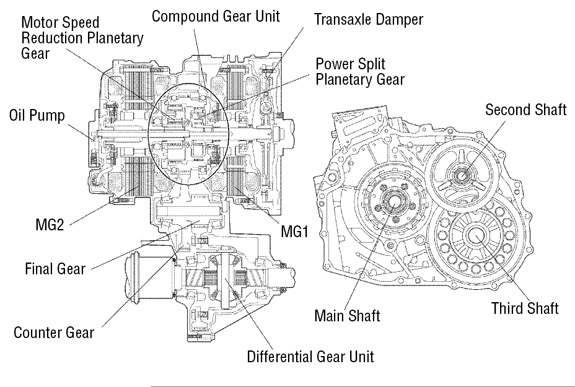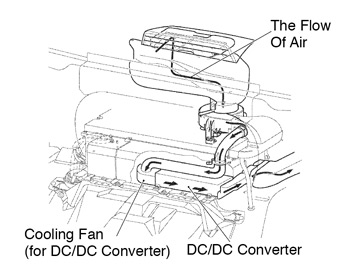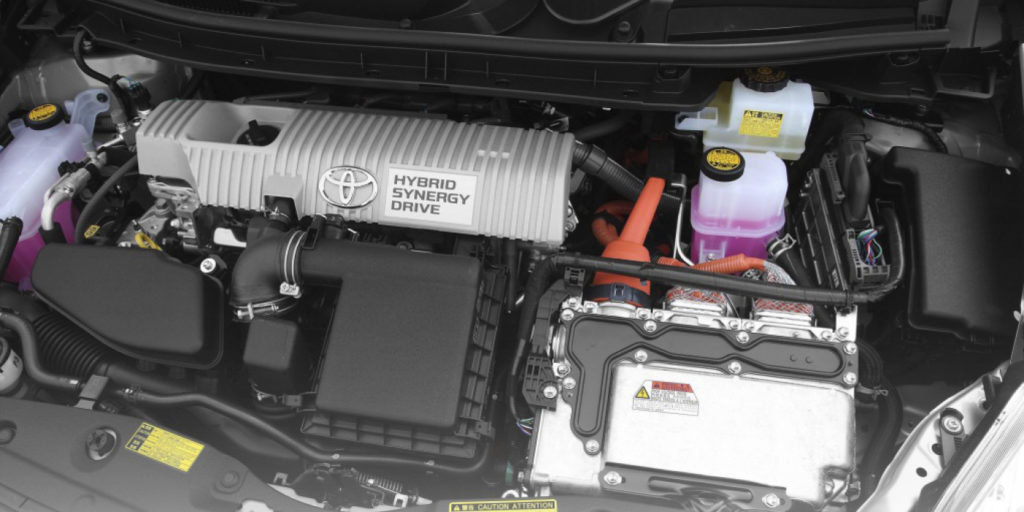Voltage from the 244.8-volt hybrid battery is stepped up to 650 volts AC by the inverter in the engine compartment to power the MG1 and MG2 electric motors. The inverter has its own cooling system, which is separate from the engine’s cooling system, and routes coolant through a sub-radiator located in front of the regular radiator and condenser. The transmission also shares the cooling circuit with the inverter, and there is a separate electric pump to circulate the coolant when the start/stop button has been pressed and the hybrid system shows “READY.”
The battery pack also has a DC-to-DC converter that converts the hybrid’s battery’s 244.8 volts to 12 volts to power the vehicle’s electrical system. The hybrid system also routes current to recharge the “auxiliary” 12-volt battery, that is also located in the trunk.
 The hybrid battery pack has its own cooling fan to keep the battery from getting too hot. The fan speed is variable, so the amount of cooling can be increased or decreased as needed, depending on the power or charging load the battery is experiencing. The fan may run only at low speed or switch off entirely when the A/C is on. The inlet duct for the battery fan is in the rear package shelf, so it’s important that this duct not be blocked or covered with anything.
The hybrid battery pack has its own cooling fan to keep the battery from getting too hot. The fan speed is variable, so the amount of cooling can be increased or decreased as needed, depending on the power or charging load the battery is experiencing. The fan may run only at low speed or switch off entirely when the A/C is on. The inlet duct for the battery fan is in the rear package shelf, so it’s important that this duct not be blocked or covered with anything.
HIGH-VOLTAGE PRECAUTIONS
Like the Prius and other high-voltage hybrid vehicles, the high-voltage battery packs enough energy to cause a potentially lethal shock should you accidentally come into direct contact with any of the orange-color coded high-voltage wiring or hybrid components. Note: For this reason, the high-voltage battery should always be isolated before doing any electrical repairs or other work that might bring you into contact with any of the hybrid components.
Removing the smart key from the vehicle won’t protect you. The high-voltage battery must be isolated by flipping the power disconnect switch located inside the trunk. Make sure the READY light is out before you do this, otherwise it could cause a “malfunction,” according to Nissan. Wear heavy, rubber-insulated gloves that are rated to withstand up to 1,000 volts to pull the disconnect switch.
Also, do not press the start/stop button when the high-voltage battery has been isolated from the system. This can also cause problems with the electronics and set false codes because the system can’t connect to the high-voltage battery. Ordinary maintenance such as changing the oil, filters, coolant, etc., or working on the brakes, does not require isolating the high-voltage battery. But any work on the powertrain or hybrid components does require isolating the 244.8-volt battery, and waiting at least 10 minutes before starting any work so the capacitors inside the inverter can discharge (they also store enough energy that could give you a bad shock).
SERVICE NOTES
 The Altima’s reputation for dependability and reliability has not been as good as the Prius. There have been complaints about the engine revving, poor battery charging cycles and batteries going dead.
The Altima’s reputation for dependability and reliability has not been as good as the Prius. There have been complaints about the engine revving, poor battery charging cycles and batteries going dead.
If you encounter an Altima with a dead battery (high voltage or the conventional 12V battery), do not attempt to charge the hybrid battery. The hybrid battery will be charged by the MG1 electric motor/generator once the engine is running via the hybrid control system.
If the 12V battery is low or dead, you can jump-start the system using jumper cables — but don’t hook the cables directly to the 12V battery in the trunk. Nissan provides a positive stud under the fuse box cover in the engine compartment for this purpose. Jumping here will keep any sparks away from the battery.






